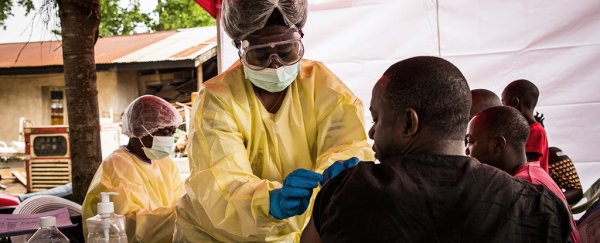The current Ebola outbreak in the Democratic Republic of the Congo (DRC) is brutal – it's the second largest Ebola outbreak on record, and has infected at least 1,273 people and killed 821.
But if there's one silver lining out of this tragedy, it's that an experimental vaccine deployed last year is estimated to be 97.5 percent effective.
The vaccine, called rVSV-ZEBOV-GP Ebola vaccine, has been provided to over 90,000 people – including nearly 30,000 health care and front line workers, likely saving many thousands of lives.
It's produced by Merck & Co, and contains a harmless live attenuated virus engineered to express a glycoprotein of Ebola. This lets the immune system become aware of how to fight the current strain of Ebola, called the Zaire strain, before being exposed to the infection.
The outbreak - which began in August 2018 – is currently contained to two areas: the North Kivu and Ituri provinces of the DRC. But these two places are on the eastern side of the country, close to South Sudan, Uganda, and Rwanda, and although the virus hasn't yet spread, it's a real possibility unless things get under control.
Despite this precarious position, the World Health Organisation (WHO) has opted not to declare a global health emergency, after an emergency panel of experts met in Geneva on Friday.
"Although there was great concern about some raising numbers in some regions, the outbreak has not spread internationally," Robert Steffen, Chair of the Emergency Committee, told media.
That being said, with the 2014 outbreak infecting 30,000 people, and causing over 11,000 deaths, Steffen says the non-declaration doesn't "mean we can lean back and relax".
Since the outbreak started, Merck & Co has shipped almost 145,000 doses, with around 100,000 more set to go in the next few months.
The researchers are focusing on a strategy called 'ring vaccination', vaccinating only those that are most likely to be infected, such as a community group where someone has developed Ebola.
"Only 8.8 percent of the vaccinated rings reported Ebola cases, and only 2.2 percent reported Ebola cases 10 days or more after vaccination," explain the researchers.
"These early results confirm previous observations of high efficacy of rVSV-ZEBOV-GP Ebola vaccine against disease."
"The ring vaccination strategy works because of the rapid protection after single dose, and high coverage achieved in the rings," they added.
But no one is in the clear yet. Amidst the crisis, mistrust of officials and health workers is high in the DRC populace, and in a recent study published in the journal Lancet Infectious Diseases, researchers found only 32 percent of respondents thought the local authorities represented their interests, and 25 percent thought the outbreak wasn't real.
Trish Newport from Doctors Without Borders is also sounding the alarm – explaining to AP that 75 percent of new Ebola cases have no obvious link to previous patients, meaning that officials have lost track of the virus's spread.
So, even with a highly effective vaccine, we'll need to make sure all hands are on deck to get this outbreak under control.
You can read more about the preliminary results of the vaccine in a WHO research paper here.
